Year 451 BC | ||
 | ||
Similar Artemision Bronze, Charioteer of Delphi, Doryphoros, Discobolus, Apoxyomenos | ||
Riace bronzes
The Riace bronzes (Italian Bronzi di Riace [ˈbrondzi di riˈaːtʃe]), also called the Riace Warriors, are two full-size Greek bronzes of naked bearded warriors, cast about 460–450 BC that were found in the sea near Riace in 1972. The bronzes are currently located at the Museo Nazionale della Magna Grecia in the southern Italian city of Reggio Calabria, Italy.
Contents
- Riace bronzes
- Riace bronzes i bronzi di riace
- Discovery
- History and origin
- 20092011 restoration
- Mythology
- References

They are two of the few surviving full-size ancient Greek bronzes (which were usually melted down in later times), and as such demonstrate the superb technical craftsmanship and exquisite artistic features that were achieved at this time.
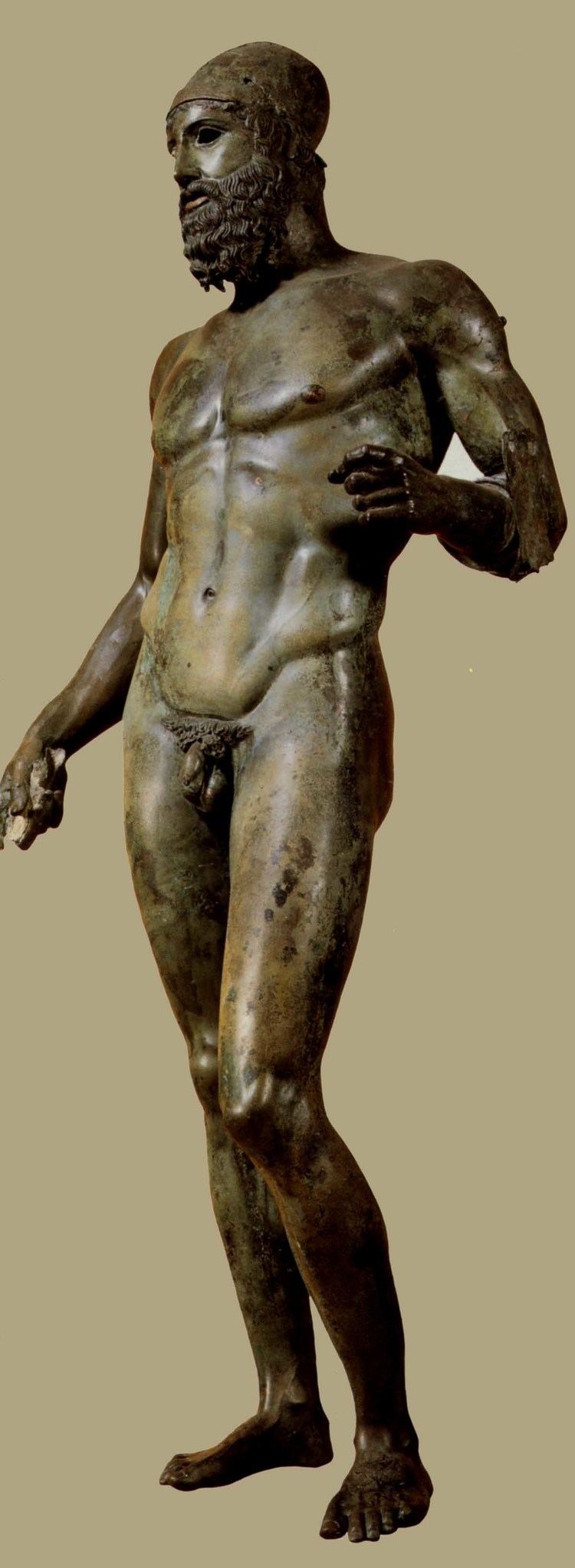
The bronzes are on display inside a microclimate room on top of an anti-seismic Carrara marbled platform. Along with the bronzes, the room also contains two head sculptures: “la Testa del Filosofo” and “la Testa di Basilea”, which are also from the 5th century BC.

Although the bronzes were rediscovered in 1972, they did not emerge from conservation until 1981. Their public display in Florence and Rome was the cultural event of that year in Italy, providing the cover story for numerous magazines. Now considered one of the symbols of Calabria, the bronzes were commemorated by a pair of Italian postage stamps and have also been widely reproduced.

The two bronze sculptures are simply known as “Statue A”, referring to the one portraying a younger warrior, and “Statue B”, indicating the more mature-looking of the two. Statue A is 203 centimetres tall while Statue B stands 196.5 centimetres tall.
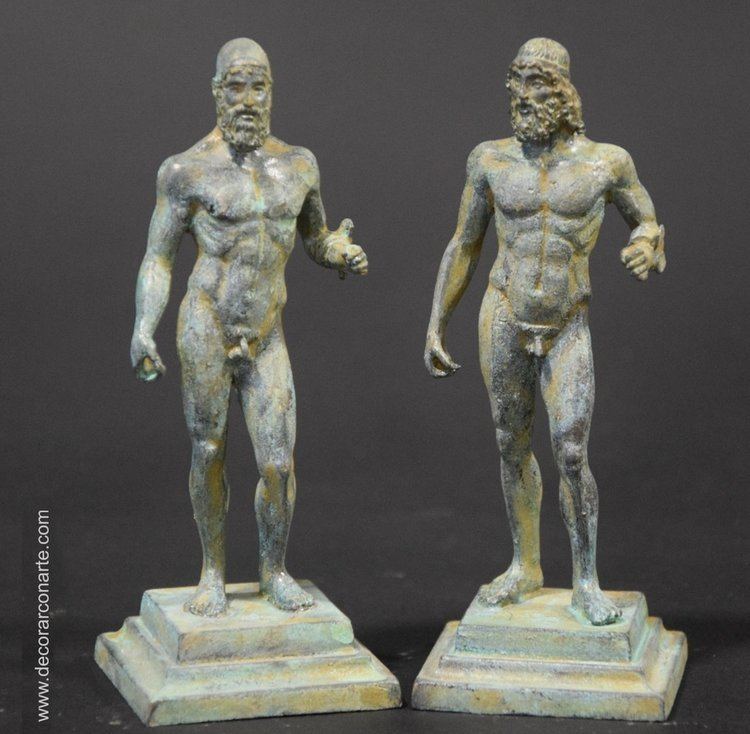
Riace bronzes i bronzi di riace
Discovery
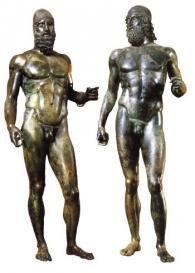
Stefano Mariottini, then a chemist from Rome, chanced upon the bronzes while snorkeling near the end of a vacation at Monasterace. While diving some 200 metres from the coast of Riace, at a depth of six to eight metres, Mariottini noticed the left arm of statue A emerging from the sand. At first he thought he had found a dead human body, but on touching the arm he realized it was a bronze arm. Mariottini began to push the sand away from the rest of statue A. Later, he noticed the presence of another bronze nearby and decided to call the police. One week later, on August 21, statue B was taken out of the water, and two days after that it was the turn of statue A. No associated wreck site has been identified, but in the immediate locality, which is a subsiding coast, architectural remains have also been found.
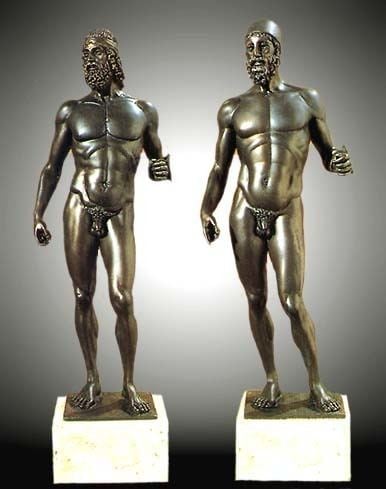
The bronzes and the story of their discovery were featured in the first episode of the 2005 BBC television documentary series How Art Made the World, which included an interview with Stefano Mariottini.
History and origin
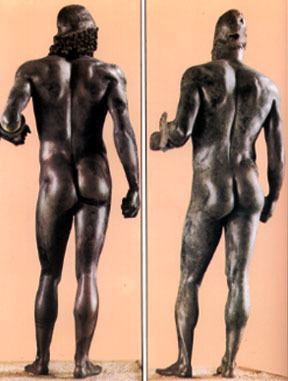
The most popular theory is that two separate Greek artists created the bronzes about 30 years apart around the 5th century BC. “Statue A” was probably created between the years 460 and 450 BC, and “Statue B” between 430 and 420 BC. Some believe that “Statue A” was the work of Myron, and that a pupil of Phidias, called Alkamenes, created “Statue B”. Statue A portrays a young warrior hero or god with a proud look, conscious of his own beauty and power. Statue B, on the other hand, portrays an older more mature warrior hero with a relaxed pose and a kind and gentle gaze.
The Riace bronzes are major additions to the surviving examples of ancient Greek sculpture. They belong to a transitional period from archaic Greek sculpture to the early Classical style, disguising their idealized geometry and impossible anatomy under a distracting and alluring "realistic" surface. They are fine examples of contrapposto - their weight is on the back legs, making them much more realistic than with many other Archaic stances. Their musculature is clear, yet not incised, and looks soft enough to be visible and realistic. The bronzes' turned heads not only confer movement, but also add life to the figures. The asymmetrical layout of their arms and legs adds realism to them. Archeologists believed that Statue A’s eyes were made of ivory, but researchers have found no organic material present in the eyes during a recent restoration analysis. Instead, the statues' eyeballs are formed of calcite, while their teeth are made with silver. Their lips and nipples are made of copper. At one time, they held spears and shields, but those have not been found. Additionally, Warrior B once wore a helmet pushed up over his head, and it is thought that Warrior A may have worn a wreath over his.
It is not impossible that the statues were on their way to a local destination. Further explorations undertaken in 2004 by a joint Italian-American team of archaeologists identified the foundations of an Ionic temple on this slowly subsiding coast. Undersea explorations by robotic vehicles along the submerged coastline from Locri to Soverato are providing a more detailed picture of this coast in Antiquity, although no further bronzes comparable to those of Riace have been found.
Attributions of such spectacular works of art to famous sculptors have followed traditional lines: "all the 'big' names of Classical times have been proposed in this connection", Brunilde Sismondo Ridgeway writes, noting that she finds it encouraging that at least a few scholars are willing to consider a non-Attic, even a 'colonial' workshop of origin, as contrasted with "the dominant Athenocentrism of previous years."
While it is certain that the bronzes are original works of the highest quality, it has also been argued that their torsos have been produced from a single model, which was then altered with direct modifications to the wax before casting, so that they may be seen as types.
2009–2011 restoration
In December 2009, the Riace Bronzes were transported to the Palazzo Campanella before restoration work began on the Museo Nazionale della Magna Grecia. Early 2010, expert art restorers Cosimo Schepis (also known as Nuccio Schepis) and Paola Donati began restoration work on the Riace bronzes. Restoration work on the two bronze sculptures was completed in 2011.
Mythology
There is no clear testimony in ancient literature to identify the athletes or heroes depicted by the bronzes. It seems that the two nudes originally formed part of a votive group in a large sanctuary. It is conjectured that the bronze sculptures may represent Tydeus and Amphiaraus respectively, two warriors from the Seven Against Thebes monumental group in the polis of Argos, as Pausanias noted. However, they may also be Athenian warriors from Delphi, part of the monument to the Battle of Marathon, or they may come from Olympia. Argos, Delphi and Olympia were three prominent Greek sites for dedicated sculpture of the highest quality, and all three were vulnerable to official plundering following the Roman occupation. Perhaps the bronzes were being transported to Rome as booty when a storm overtook their ship, although no evidence of a wreck has been found. Salvatore Settis and Vinzenz Brinkmann identify the warriors as Erechtheus, son of Athena, and Eumolpos, son of Poseidon.
